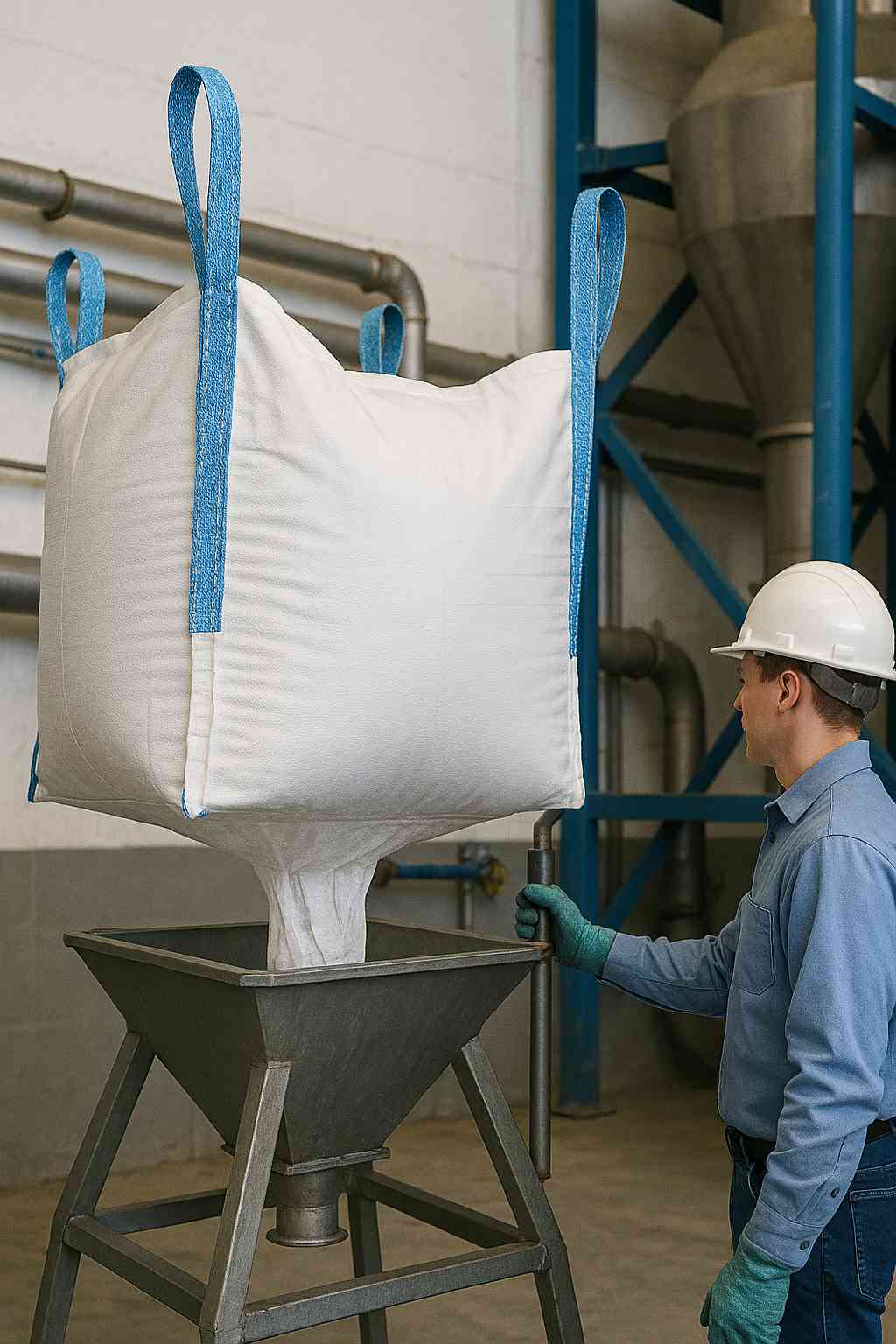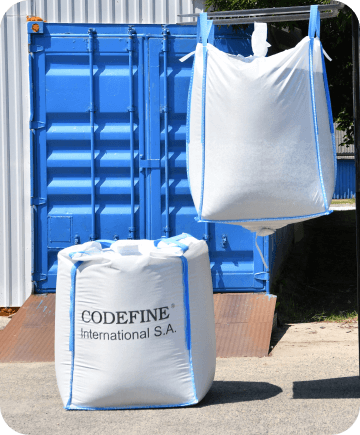Home » Posts Page » Blog » Products and Materials » Bulk Bag Unloading Guide: Tips for Safe and Efficient FIBC Handling with the Right Equipment

Flexible intermediate bulk containers (FIBCs) are a common choice of industrial packaging. Made from robust materials like woven polypropylene and other plastic polymers, these hard-wearing containers are utilized by a wide variety of industries and are well-suited to more demanding applications.
However, while FIBCs are versatile and cost-effective, you can encounter some problems when integrating them into your operation. Regular FIBC challenges include material flow problems, with obstructions common when filling and discharging larger materials. When handling finer materials like grains and powders, dust control can be an issue, which can present a health hazard in some cases and fire risks in a worst-case scenario.
There’s also the general issue of handling safety. To handle FIBCs safely, you’ll need to ensure you’re using the right equipment. Fortunately, there are many different solutions available that make moving easy. From bag unloaders to mechanical lifting machinery, it’s easy to reduce your manual labor burden, eliminate health and safety risks, and streamline workflows with the right equipment.
To prevent accidents and minimize risk to your labor force, it’s important to follow the latest OSHA guidelines and industry safety standards when handling bulk bags. Using lifting equipment can greatly reduce the margin for human error, preventing common workplace injuries. Before using machinery to handle bulk bags, make sure lifting loops are in good condition and the containers themselves are free of wear and tear. You’ll also need to consider safe working loads when handling bulk bags, and never overfill FIBCs beyond their quoted maximum.
If you’re looking to minimize material loss when handling bulk bags, you might want to reconsider your filling and discharging options. Different styles of tops are available for bulk bags, which can help prevent spillage, protecting your profits while avoiding contamination of the surrounding environment. Dust from grains and granular products can pose a health hazard, while combustible materials can lead to fires if you’re not using bags with anti-static protection.
To prevent material loss, spout-style tops are a good idea if you’re looking for greater control and less loss when filling. When discharging materials, avoid standard openings and choose spouts and valve mechanisms that allow for the controlled emptying of stored contents.
To counter static electricity risks, reconsider the type of FIBC you are using. Type A bulk bags offer no anti-static protection, while Type B bags only offer a limited amount of protection. Type C and Type D bags are far more reliable at combating electrostatic charges thanks to their conductive materials and special construction. However, you’ll need to ensure Type C bags are properly grounded prior to filling and discharging.
Looking for easy ways to expedite your workflows? Unloading equipment can speed up workflows and reduce the need for manual labor. Let’s take a closer look at some of the most common bulk bag unloading equipment you’ll encounter.
Sometimes known as FIBC or container dischargers, bulk bag unloaders are another common type of unloading equipment and come in many forms. Bulk bag unloaders are tubular in design and come in a variety of forms.
Lifting equipment is an essential part of the unloading process. Bulk bag lifters offer easy-to-handle bags in a safe manner. With their sturdy frame-style construction, they’re ideal for heavy loads and can minimize safety risks. What’s more, they can be customized to accommodate bulk bags of different sizes, as well as other types of containers.
When it comes to emptying FIBCs, several different discharge systems are available. Common discharge options include valve-style mechanisms, which allow for a great degree of control. This is useful when working with finer materials, particularly high-value ones used in the chemical and pharmaceutical industries.
Bulk bag stands and frames are essential for any operation that uses FIBCs. These pieces of equipment keep bulk bags taut during filling, allowing for bags to be filled evenly while preventing waste.
Dust control is a major concern when working with finer materials like grains and powders. Fortunately, there are several ways you can counter this problem. Spout-style tops and discharge mechanisms prevent excess dust from contaminating your work environment while allowing for better material control.
It’s important to observe health and safety regulations when unloading bulk bags. Firstly, you’ll need to prepare the unloading area to minimize risks. Clear away any obstructions that might get in the way of workers or lifting and unloading equipment. If you’re handling hazardous materials and aren’t working with anti-static bulk bags, ensure the area is free of combustible material.
Next, you’ll need to inspect the condition of the bag you’re about to unload. Look for general signs of wear and tear before unloading gets underway. If you’re using a crane or lifting device, check the condition of the lifting loops to prevent accidents. It’s also important to verify that the container hasn’t been filled beyond its safe working load.
To minimize product loss when discharging, containers also need to be properly positioned. Make sure lifting equipment, bulk bags, frames, and stands are properly aligned to avoid this and allow for more controlled discharging.
If you’re handling finer materials, material flow can be a problem. To avoid this issue when discharging, you may need to bring in other equipment to encourage material flow. Vibrating tables are one option for loosening materials and increasing flow, while a range of agitation tools can also be employed. Pipe agitators can be used to vibrate the framework of bulk bag unloaders, while vibrating hoppers provide additional agitation during discharging.
To safely handle bulk bags during unloading, make sure you’re always using proper lifting techniques, making use of the lifting loops located at the top of the container. These should only ever be attached to the top of the container and remain vertical during lifting.
Additionally, make sure your unloading equipment is compatible with the container loads you’re working with. Any forklift used to lift an FIBC needs to be able to support the full weight of the loaded bag. The same applies to any type of unloading equipment you plan on using during discharging.
You’ll also need to consider dust control to minimize risk to human health and avoid potential hazards. Bulk bag discharge attachments can help keep dust contamination to a minimum. Ventilation systems can also be used to eradicate excess dust from your workspace.
If you want to streamline operations, maximize efficiency, and increase profits, it makes sense to integrate automated solutions. Essential for high-volume operations, equipment like cranes can significantly reduce the need for manual labor, boosting productivity and reducing health and safety concerns.
However, your labor force will ultimately need to interact with bulk bag unloading equipment at some point. To ensure optimal efficiency and reduce the chance of accidents, ensure your team is fully trained on how to use equipment, along with best unloading practices.
Your unloading equipment also needs to be maintained to ensure it’s working as well as it should. Regularly inspect your machinery and equipment for signs of wear and tear, investing in servicing as and when required.
If you’re looking to speed up the unloading process and reduce your labor demand, bulk bag unloading equipment is essential. However, you’ll first need to invest in quality FIBCs. If you’re in the market for premium industrial packaging, why not explore Codefine’s extensive product range online today? We’ve been providing reliable packaging solutions to clients since 1957, leading the way when it comes to innovation.
Keen to discuss your requirements in more detail? Get in touch with the team today to discuss our products in more detail or to arrange a quote.
